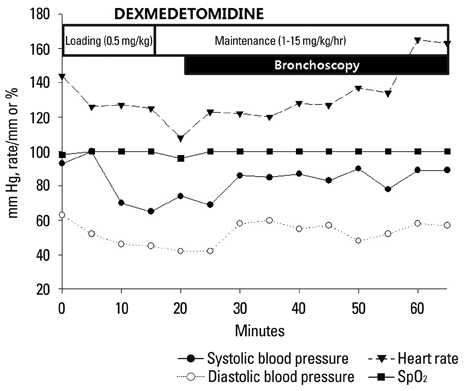Yonsei Med J.
2014 Mar;55(2):539-541.
Dexmedetomidine for Rigid Bronchoscopy in an Infant with Tracheal Web after Ventricular Septal Defect Patch Repair
- Affiliations
-
- 1Department of Anesthesiology and Pain Medicine, Severance Hospital, Yonsei University College of Medicine, Seoul, Korea. ktmin501@yuhs.ac
Abstract
- We report herein successful rigid bronchoscopy with preserved spontaneous breathing of a 54-day-old infant with tracheal web associated with previous ventricular septal defect (VSD) repair. We considered the use of dexmedetomidine in conjunction with intermittent ketamine from the following three clinical aspects. First, this infant was suffering from respiratory distress with chest retraction, the cause of which was not revealed by a computerized scan of the neck and chest. Second, the patient was scheduled for rigid bronchoscopy, which is accompanied by brief but strong stimulation. Third, this infant underwent congenital VSD heart repair approximately 1 month earlier.
Keyword
MeSH Terms
Figure
Reference
-
1. Shukry M, Miller JA. Update on dexmedetomidine: use in nonintubated patients requiring sedation for surgical procedures. Ther Clin Risk Manag. 2010; 6:111–121.
Article2. Silver AL, Yager P, Purohit P, Noviski N, Hartnick CJ. Dexmedetomidine use in pediatric airway reconstruction. Otolaryngol Head Neck Surg. 2011; 144:262–267.
Article3. Mason KP, Lerman J. Review article: Dexmedetomidine in children: current knowledge and future applications. Anesth Analg. 2011; 113:1129–1142.4. Shukry M, Kennedy K. Dexmedetomidine as a total intravenous anesthetic in infants. Paediatr Anaesth. 2007; 17:581–583.
Article5. Barton KP, Munoz R, Morell VO, Chrysostomou C. Dexmedetomidine as the primary sedative during invasive procedures in infants and toddlers with congenital heart disease. Pediatr Crit Care Med. 2008; 9:612–615.
Article6. Loria CJ, Stevens AM, Crummy E, Casadesus G, Jacono FJ, Dick TE, et al. Respiratory and behavioral dysfunction following loss of the GABAA receptor α4 subunit. Brain Behav. 2013; 3:104–113.
Article7. Jenkins A, Franks NP, Lieb WR. Effects of temperature and volatile anesthetics on GABA(A) receptors. Anesthesiology. 1999; 90:484–491.8. Bai D, Pennefather PS, MacDonald JF, Orser BA. The general anesthetic propofol slows deactivation and desensitization of GABA (A) receptors. J Neurosci. 1999; 19:10635–10646.
Article
- Full Text Links
- Actions
-
Cited
- CITED
-
- Close
- Share
- Similar articles
-
- Surgical Treatment of Complete Atrioventricular Septal Defect with Tetralogy of Fallot: Report of one case
- Reoperation of Postinfarction VSD
- One Stage Repair of Traumatic Ventricular Septal Defect and Mitral Regurgitation
- Anatomical Repair of Double-Outlet Left Ventricle with Ventricular Septal Defect and Pulmonary Stenosis by Reight Ventricular Outflow Patch Reconstruction
- Complete Repair of Coarctation of the Aorta and a Ventricular Septal Defect in a 1,480 g Low Birth Weight Neonate


